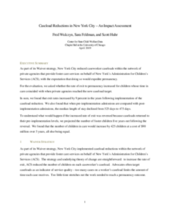EXECUTIVE SUMMARY
As part of its Waiver strategy, New York City reduced caseworker caseloads within the network of private agencies that provide foster care services on behalf of New York’s Administration for Children’s Services (ACS), with the expectation that doing so would expedite permanency.
For the evaluation, we asked whether the rate of exit to permanency increased for children whose time in care coincided with when private agencies reached the new caseload target.
In sum, we found that exit rates increased by 9 percent in the years following implementation of the caseload reduction. We also found that when pre-implementation admissions are compared with postimplementation admissions, the median length of stay declined from 525 days to 475 days.
To understand what would happen if the increased rate of exit was reversed because caseloads returned to their pre-implementation levels, we projected the number of foster children five years out following the reversal. We found that the number of children in care would increase by 425 children at a cost of $90 million over 5 years, all else being equal.

